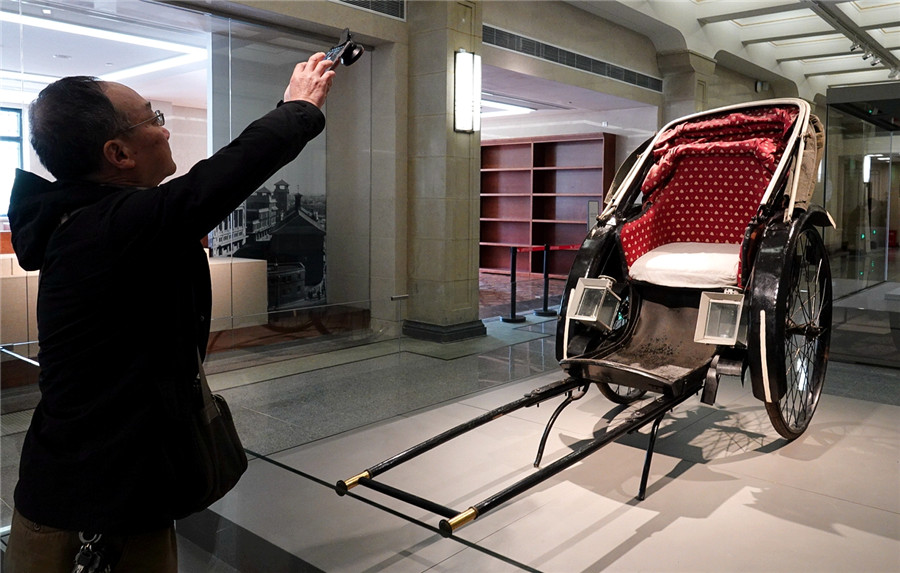 |
|
A huangbaoche pedicab is shown at the newly reopened Shanghai History Museum. [Photo by Gao Erqiang/China Daily] |
The Shanghai History Museum has reopened in two historical buildings to display many items related to the city's legacy for the first time.
The Shanghai History Museum's (Shanghai Revolution Museum's) most important exhibits are the buildings that house it, director Hu Jiang says.
The museum, which officially opened downtown on March 26, consists of two structures built in the 1920s and '30s as the Shanghai Race Club in the former international settlement.
The race courses in People's Square have been replaced by high-rise buildings and public institutions over the decades. But the two buildings have survived and are recognized among the city's important cultural relics.
"My grandma used to live nearby, and we used to walk by the gate all the time," recalls Zhang Beifen, a woman in her 50s who was among the museum's first visitors on the opening day.
"I've witnessed it become the Shanghai Library, the Shanghai Museum, the Shanghai Art Museum and now the Shanghai History Museum."
The buildings became public assets after Shanghai was liberated in 1949.
The mayor at the time, Chen Yi (1901-72), decided to repurpose them as the Shanghai Library and Shanghai Museum. The Shanghai Museum moved away 1959, and the Shanghai Library relocated in 1997.
The buildings became home to the Shanghai Art Museum until 2012, when it moved to the former Chinese pavilion at the World Expo 2010.
The Shanghai History Museum dates back to the 1950s. It was initially located on Huqiu Road and later moved to several different locations.
The two-year restoration of the buildings started in 2015, when the municipality decided to move the history museum to the site.
Workers used the same materials as the original structure.
Visitors to the newly opened Shanghai History Museum start from the east wing, where permanent exhibitions portray the city's history.
An elaborately decorated sedan chair commissioned by a merchant from nearby Zhejiang province greets them in the lobby.
He hired 10 experienced wood carvers, who took 10 years to complete the piece. It features hundreds of traditional Chinese opera characters rendered in wood, painted glass, lacquer and embroidery. It was then the showpiece of his Wuhua Leasing Shop for Wedding and Funeral Articles.
Many of the craftsmanship genres used to make the chair have been lost amid rapid modernization.
The ground floor exhibition hall features a giant LED screen as well as interactive electronic games that visitors can play to learn about Shanghai's past.
Two bronze lions created by British artist Henry Poole occupy the central space in front of the big screen. They were commissioned to adorn the Bund-facing entrance of the Hong Kong and Shanghai Banking Corp in 1923, when the financial institution opened its new Shanghai office. The creatures guarded the bank until 1966, when the Shanghai History Museum added them to its collection.
A 77-year-old visitor, who only gave his surname, Tang, recalls seeing the lions when he played on the Bund as a child.
"Every edge, crack and corner on the lions is so familiar to me," he says.
"This is the museum of our own city's history. Lots of tourists will come. We locals should, too."
The upstairs area's displays chronicle Shanghai's changes, starting with relics from 6,000 years ago. It features a cannon used in the first Opium War (1840-42). Other displays reveal the development of art, culture and industrialization over the centuries. About four-fifths of the items are on public display for the first time.
The west wing's exhibits open with over 50 displays about the former mayor Chen, donated by his children.
"My father spent the happiest years of his career in Shanghai," his son Chen Danhuai says.
On show are the piano, desk, gramophone and other objects Chen Yi and his wife, Zhang Qian, used during their stay in the city.
He later served as China's foreign minister. The qipao dresses made by Shanghai's Hongxiang Fashion Co that she wore for official overseas visits are also displayed.
The museum is also hosting two temporary exhibitions that will run until June 24. One is about how The Communist Manifesto ignited the Chinese revolution, while the other details the history of the museum buildings.
If you go
9 am-5 pm, Tuesday to Sunday. 325 Nanjing Road West, Huangpu district, Shanghai.
021-6323-2504.

Presented by Chinadaily.com.cn Registration Number: 10023870-7
Copyright © Ministry of Culture, P.R.China. All rights reserved